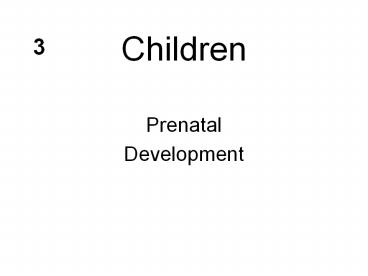Children - PowerPoint PPT Presentation
1 / 15
Title:
Children
Description:
Children 3 Prenatal Development The Fetal Period Begins two months after conception; lasts about seven months, until birth Largest prenatal size and weight gains ... – PowerPoint PPT presentation
Number of Views:83
Avg rating:3.0/5.0
Title: Children
1
Children
3
- Prenatal
- Development
2
The Fetal Period
The Course of Prenatal Development
- Begins two months after conception lasts about
seven months, until birth - Largest prenatal size and weight gains
- Fingers, toes, skin, features, lungs, other
structures, and reflexes all develop to prepare
for birth - The three trimesters are not the same as the
three prenatal periods
3
The Brain
The Course of Prenatal Development
- At birth 100 billion neurons
- Basic architecture assembled during first two
trimesters - Neural tube first 1824 days
- Neurogenesis
- Neuronal migration 46 weeks after conception
4
Nutrition and Weight Gain
Strategies for Expectant Mothers
- Nutrition
- Need for protein, iron, vitamin D, calcium,
phosphorus, magnesium increases 50 percent, water
is essential - Weight Gain
- 25 to 35 pounds associated with best reproductive
outcomes - Inadequate and excessive weight gain may affect
baby birth weight or mothers health
5
Exercise During Pregnancy
Strategies for Expectant Mothers
- Decrease duration and intensity as pregnancy
progresses - Avoid high-risk activities
- Warm up, stretch, cool down
- Reduce exercise significantly in last four weeks
- Several studies show exercise during pregnancy
not linked to preterm birth
6
Prenatal Care
Strategies for Expectant Mothers
- Prenatal care varies enormously in
- Education
- Screening for manageable conditions and treatable
diseases - Information on risks and choices before, during,
and after pregnancy - Good prenatal care makes a difference
- Reduces mortality, physical problems later
7
Prenatal Care
Strategies for Expectant Mothers
- Other countries outside the U.S.
- Have lower rate of low-birth-weight infants
- Free or low-cost prenatal and postnatal care
- Enjoy liberal paid maternity leave
- Factors affecting prenatal care in U.S.
- Individual and social characteristics
- Inadequacy of health care system
- Age group differences (adolescents, adults)
8
Percentage of U.S. Women Using Timely Prenatal
Care 1990 to 2004
Fig. 3.6
9
Cultural Beliefs About Pregnancy
Strategies for Expectant Mothers
- Conflict between cultural tradition and Western
medicine during pregnancy - Food craving satisfaction
- Hot-cold theory of illness
- Extended family involvement
- Stoicism valued by many Asians
- Pregnancy as a natural occurrence or a medical
condition
10
Some General Principles
Hazards to Prenatal Development
- Teratogen
- Any agent that causes a birth defect
- Severity and type of defect affected by
- Dose, genetic susceptibility, time of exposure
- All drugs (prescribed, illegal) can have effects
on unborn fetus - Antibiotics, analgesics, asthma medications
- 1961 thalidomide tragedy
11
Teratogens and Timing of Their Effects on
Prenatal Development
Zygote Embryonic period (wks)
Fetal Period (wks)
1 2 3 4 5 6 7 8 9 16 32 38
Central nervous system
Most serious damage from teratogens in first 28
weeks
Heart
Arms
Eyes
Legs
Ears
Teeth
Palate
Period of susceptibility to structural defects
External genitalia
Period of susceptibility to functional defects
Fig. 3.7 (modified)
12
Environmental Hazards
Hazards to Prenatal Development
- Fathers exposure to lead, radiation
- X-ray radiation
- Pollutants and toxin wastes
- Fertilizers and pesticides
- Lead-based paints
- Petrochemicals
13
Maternal Diseases
Hazards to Prenatal Development
- Diseases and infections cross the placenta
barrier - Rubella (German measles)
- Diabetes
- Sexually transmitted infections
- Syphilis, Genital herpes
- AIDS, HIV infection
- New medications and vaccines available
14
Other Parental Factors
Hazards to Prenatal Development
- Maternal diet, nutrition, and weight
- Folic acid and iron
- Fish PCBs and mercury levels
- Maternal age
- Highest risks adolescents, over 35 years
- Down syndrome
- Maternal emotional states
15
Other Parental Factors
Hazards to Prenatal Development
- Paternal factors
- Fathers diet and low vitamin C
- Drug use effects on sperm
- Smoking effects of second-hand smoke
- Fathers age at conception
- Birth defects dwarfism, Marfans Syndrome




















![Jesus Loves the Little Children [580 Green] PowerPoint PPT Presentation](https://s3.amazonaws.com/images.powershow.com/7625197.th0.jpg?_=20160221035)










